Your cart is currently empty!
Tag: Oxford PAT
-
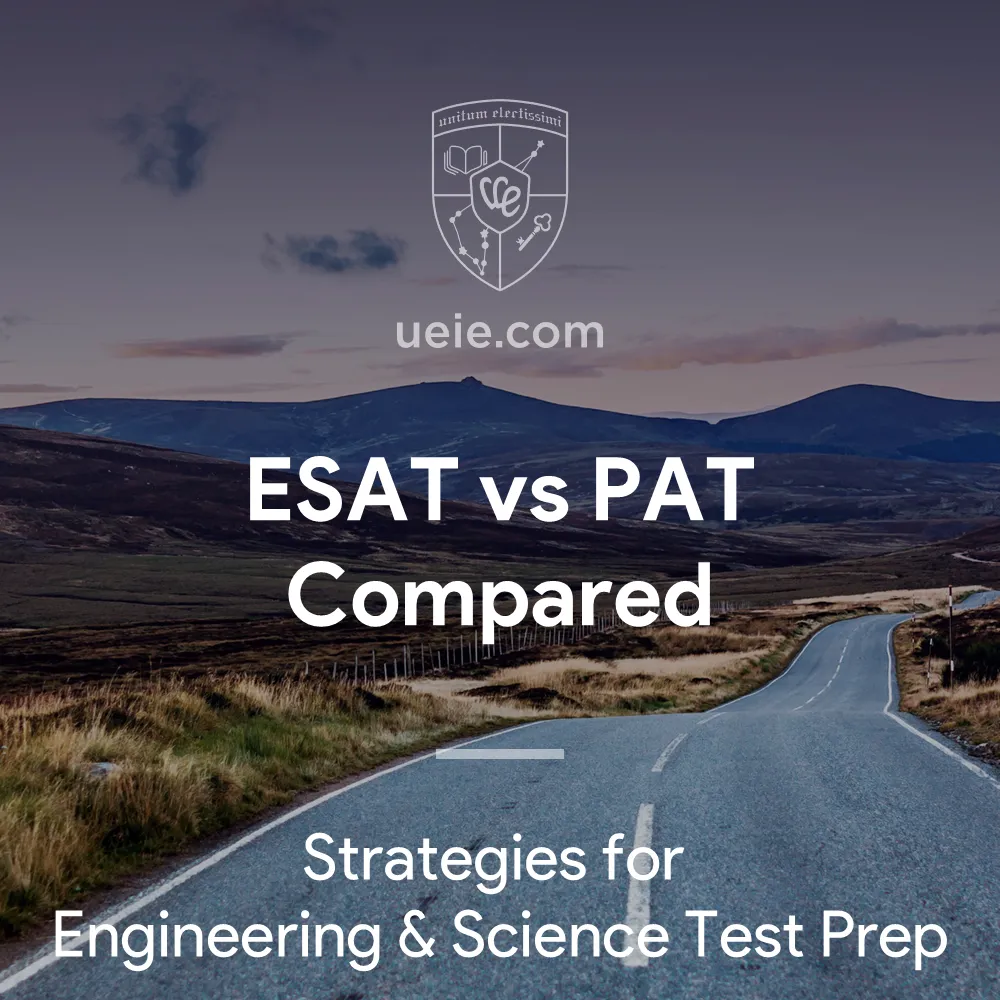
ESAT vs PAT Comparison: Strategies for Engineering & Science Test Prep
I. ESAT vs PAT: How to Choose Your Key to Top Science and Engineering Universities?
For students and parents preparing applications for engineering or science courses at Oxford, Cambridge, and Imperial College London, the names PAT (Oxford Physics Aptitude Test) and ESAT (Engineering and Science Admissions Test) will likely ring a bell. These are crucial ‘acid tests’ used by these top-tier institutions to select applicants for their science and engineering disciplines.
A common question naturally arises, particularly for those students and parents aiming for engineering or physics programmes at both Oxford and Cambridge/Imperial College: Given that both are science and engineering-related examinations, how significant are the differences between ESAT and PAT? If my child needs to prepare for both, is there an efficient way to combine their preparation? Or are they entirely distinct, requiring separate and independent study?
Admittedly, not all science applicants will need to tackle both examinations. For instance, those applying for courses in chemistry or biology-related fields (ESAT is required for Chemical Engineering and Biotechnology, biological streams of Natural Sciences, and Veterinary Medicine at Cambridge) or materials science (PAT is required for Oxford) typically only need to prepare for one.
This article will delve into the core similarities and differences between the ESAT and PAT examinations. Our aim is to clarify the landscape for all students and parents interested in ESAT and PAT. Specifically for those needing to prepare for both – students applying for engineering or physics – we will focus on analysing the ‘correlation’ and ‘differences’ in their preparation, offering an effective combined strategy. For students who only need to take one examination, this comparison will also provide a deeper understanding of the unique aspects of the exam they face, thereby enabling more targeted preparation.
II. ESAT vs PAT: A Table for Understanding Core Information
First, let’s condense the key information about ESAT and PAT into a table. This will allow you to quickly grasp their overall structure and core differences.
Dimension ESAT Oxford PAT Managing Body UAT-UK University of Oxford Exam Administrator Pearson VUE Pearson VUE Answering Format Online computer-based Online computer-based Paper Structure Total of 5 modules, typically choose 3:
-
- Mathematics 1
- Mathematics 2
- Physics
- Chemistry
- Biology
Unified paper: Mathematics + Physics Question Types and Volume 81 multiple-choice questions (3 modules, 27 questions/module) 40 multiple-choice questions Examination Duration 2 hours in total (3 modules, 40 minutes/module) 2 hours Knowledge Base A Level + GCSE Mathematics / Physics / Chemistry / Biology (depending on selected modules) A Level + GCSE Mathematics + Physics Further Mathematics Not required Not required Scoring Method Standardised score: 1.0-9.0 (after raw score conversion) Raw score: 0-100 Calculator Not permitted Online calculator provided (personal calculators forbidden) Dictionary and Formula Sheet Not permitted Not permitted Required by University/Department - Cambridge: Engineering, Natural Sciences, Chemical Engineering and Biotechnology, Veterinary Medicine
- Imperial College London: Department of Aeronautics, Department of Chemical Engineering, Department of Civil and Environmental Engineering, Dyson School of Design Engineering, Department of Electrical and Electronic Engineering, Department of Mechanical1 Engineering, Department of Physics
- UCL: Electronic and Electrical Engineering
- Oxford: Physics, Physics and Philosophy, Engineering, Materials Science
Summary
As the table above illustrates, both ESAT and PAT are online, multiple-choice examinations administered by Pearson VUE, aimed at applicants for top university science and engineering courses, and neither requires knowledge of Further Mathematics. However, they differ in the breadth of subjects covered (ESAT is broader), whether they are modular (ESAT is), calculator policies, and the final presentation of scores (standardised score vs. raw score).
III. Analysis of Similarities and Differences: Feasibility and Key Points for Combined Preparation
Having grasped the core information, let’s now delve into the feasibility of preparing for ESAT and PAT concurrently, highlighting key areas that demand particular attention.
1. Where does the ‘Feasibility’ of Combined Preparation Lie?
For students aiming to tackle both examinations (specifically those selecting the Mathematics 2 + Physics modules for ESAT), a combined preparation strategy is indeed feasible. This is primarily due to the following commonalities:
Overlapping Mathematical and Physics Knowledge
The content required for ESAT’s Mathematics 1, Mathematics 2, and Physics modules significantly overlaps with the A-Level/GCSE Mathematics and Physics knowledge needed for PAT. This means that when revising core topics such as functions, mechanics, electricity, and basic calculus, you can effectively ‘kill two birds with one stone.’
Shared Skillset
Both examinations place considerable emphasis on a student’s logical-mathematical reasoning, their ability to apply scientific principles to solve practical problems, and their capacity to maintain clear thinking and accuracy under pressure. Honing these core scientific literacies will benefit performance in both tests.
Similar Format
Both are online multiple-choice examinations administered via the Pearson VUE platform. Familiarity with the computer-based testing environment, on-screen reading, and multiple-choice answering techniques is transferable between the two.
2. What are the ‘Points to Note’ for Combined Preparation?
Despite these commonalities, it’s crucial not to treat ESAT and PAT as interchangeable. You must clearly recognise and specifically address the following key distinctions:
ESAT’s Modularity and Breadth
ESAT is structured into five modules: Mathematics, Physics, Chemistry, and Biology. Students must select and prepare for three of these, guided by their university application requirements. This implies a potentially broader knowledge base (particularly if Chemistry or Biology is chosen). Furthermore, during the exam, students will need to swiftly switch between different subject mindsets and manage their time effectively within the independent 40-minute slots allocated to each module.
PAT’s Integration of Physics and Mathematics, and Depth
While PAT only tests Physics and Mathematics, it strongly emphasises their deep integration in problem-solving. Questions may be more comprehensively and ingeniously designed, potentially demanding a more profound understanding of physical concepts and a more versatile application of mathematical tools.
Fundamental Difference in Calculator Policy
This is a critical distinction requiring careful attention:
- ESAT does not permit calculator use. Preparation must therefore involve significant effort in training mental arithmetic, manual calculation, estimation, unit conversion, and the fluent recall of formulae and constants.
- PAT, conversely, provides an online calculator. During preparation, students cannot rely on their familiar personal calculators. Instead, they must invest time in becoming proficient with the specific online tool provided. This includes learning to judge when to use it for complex calculations and when manual calculation or estimation might be more efficient. The training for these two distinct calculation approaches and skillsets is fundamentally different.
Differing Emphasis on Speed
ESAT allocates 40 minutes for 27 questions per module, averaging roughly 1.5 minutes per question. This demands exceptionally rapid knowledge retrieval and reaction speed. PAT, while also multiple-choice and with a total duration of 2 hours for 40 questions (averaging about 3 minutes per question), might appear slightly more relaxed. However, its questions may require more time for thorough reading, comprehension, modelling, and calculation (especially when using the online calculator). Consequently, it places equally high demands on depth of thought and problem-solving efficiency.
IV. Effective Strategy: Devising Your ESAT and PAT Preparation Plan
Having clarified the similarities and differences, we can now formulate an effective preparation strategy, particularly for students requiring combined preparation.
1. From Where Does ‘Effectiveness’ Originate? When is it Applicable?
The ‘effectiveness’ of combined preparation primarily stems from integrating common foundations. It is especially applicable to students whose application pathways cover related courses at Oxford and Cambridge/Imperial College, and who select the Mathematics and Physics modules for ESAT. Consolidating the revision of core mathematical and physical knowledge can effectively save time. However, please remember that the realisation of this efficiency must be predicated on precise, differentiated training.
2. Practical Advice: How to Approach Combined Preparation?
Step One: Confirm Modules and Self-Assess
Firstly, confirm that your chosen course requires or allows the selection of ESAT’s Mathematics 2 and Physics modules! This is the prerequisite for combined preparation. Secondly, objectively assess your proficiency in Mathematics, Physics (and other ESAT elective subjects), and your abilities both with and without calculator assistance.
Step Two: Consolidate Common Foundations
Systematically revise and consolidate the overlapping A Level Mathematics and Physics core knowledge points. Focus on conceptual understanding and mastery of fundamental principles.
Step Three: Differentiated Specialist Training
ESAT Specialist Training
- Undertake rigorous, high-intensity timed multiple-choice practice without a calculator. Focus on training speed, accuracy, and rapid knowledge retrieval skills.
- Practise adapting to module switching to simulate continuous examination conditions.
PAT Specialist Training
- Frequently use the official online practice platform to master the functions and limitations of the online calculator, and to identify the most efficient usage strategies.
- Engage in targeted practice of multiple-choice questions that integrate Physics and Mathematics and demand depth of thought.
- Critically use PAT past papers (note formatting differences prior to 2024), focusing on learning question approaches and the application of physical models.
Step Four: Simulate and Adjust
Periodically undertake full online mock examinations for ESAT (according to module combinations) and PAT, strictly adhering to time and calculator rules.
Based on mock examination results, analyse areas of weakness and promptly adjust revision priorities and training strategies.
Recommended Preparation Time
Considering the breadth of knowledge involved and the training of two different skill sets (particularly regarding calculators), it is advisable to allocate at least 5 months for systematic preparation. It is crucial to start early and ensure consistent, sustained effort.
Official Resources are Fundamental
The official ESAT and PAT websites, syllabuses, sample questions, and online practice platforms are fundamental resources that must be fully utilised.
Platforms such as Isaac Physics are beneficial for enhancing general mathematical and physical abilities.
Considering the unique nature of combined preparation, selecting courses and materials specifically designed for the characteristics of both ESAT and PAT will be significantly more effective. For example, the ESAT + PAT On-Demand Prep Suite and ESAT + PAT Live Classes offered by UEIE.
Key Recommended Resources

ESAT & PAT On-Demand Prep Suite
The ESAT & PAT On-Demand Prep Suite, developed by Xie Tao, is your all-in-one solution for exam success, which includes video lectures covering Maths, Physics, over 1600 practice questions with detailed solutions, and full-length mock exams for ESAT Maths 1, Maths 2, Physics, and the Oxford PAT. Prepare thoroughly and maximise your score.US$609 – US$2 416Price range: US$609 through US$2 416
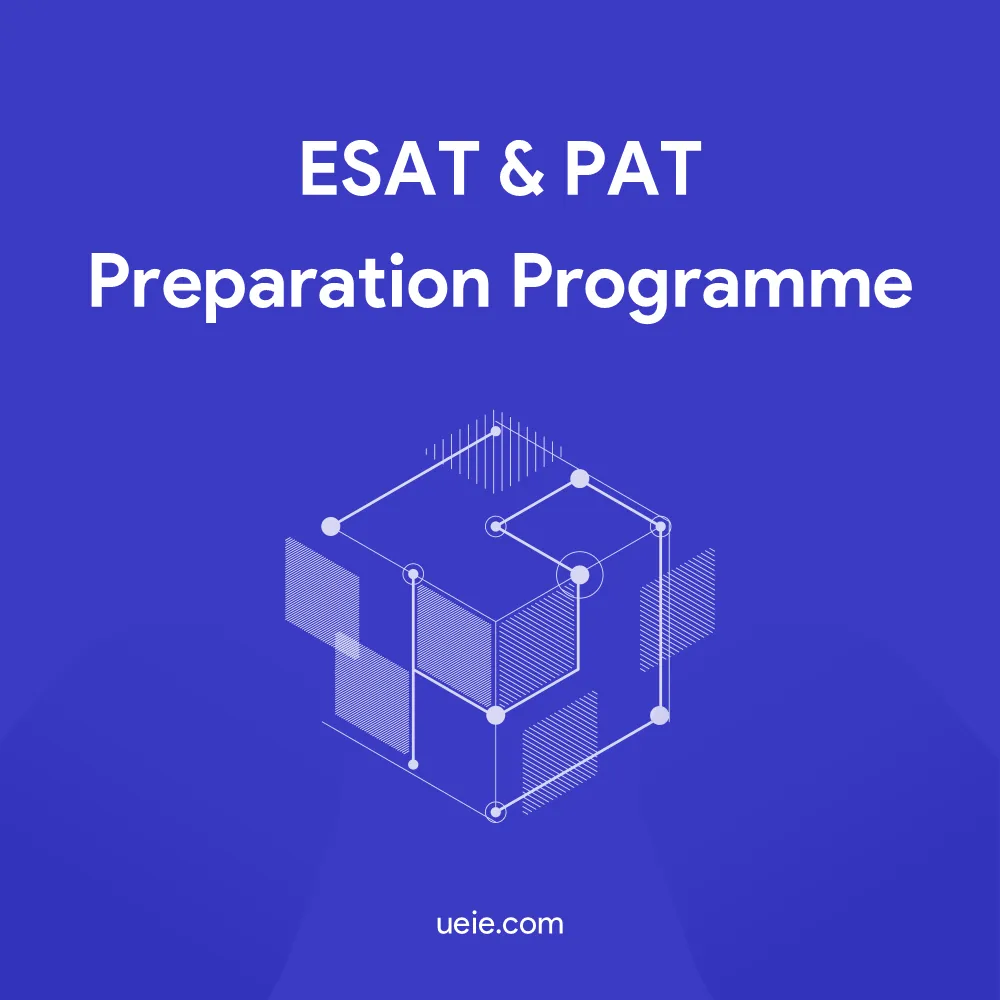
ESAT & PAT Preparation Programme
All-in-one exclusive resources. This programme features a 3000+ question bank, 9 unseen mock exams for each test, and 3 ESAT predictive papers to help you systematically master both new exams. Click to view the bundle.US$3 102 – US$12 777Price range: US$3 102 through US$12 777
The greatest value of such resources lies in their optimised learning paths and training content, already structured according to the similarities and differences between the two examinations. They can clearly guide students on what to learn first, what to practise next, and how to practise most efficiently, thereby avoiding the potential waste of time and energy that can result from students figuring things out themselves. For those pursuing efficient preparation, this is a very wise choice.
3. Key Advice for Parents/Students
Combined preparation for ESAT and PAT is feasible, particularly for students primarily targeting engineering and physics disciplines. However, it is by no means an easy undertaking. The key to success lies in acknowledging and effectively addressing the core differences, especially calculator policies and examination style/structure. Planning must be meticulous, and training must be highly targeted; one cannot simply apply ‘one method for two examinations’.
V. Conclusion: Precise Analysis, Effective Preparation
In summary, ESAT and PAT, as gateways to science and engineering courses at their respective top universities, exhibit significant differences in terms of scope, structure, style, and particularly calculator policy, despite both being online multiple-choice examinations. Through the analysis in this article, we hope to have helped you clarify their core similarities and differences.
For applicants, whether focusing on one examination or needing to tackle both, the key to success lies in precisely understanding the requirements of the target examination, planning scientifically, and undertaking targeted, effective preparation.
Want to learn more? Please see:

ESAT Prep Hub
Master the ESAT with UEIE’s Prep Hub! We offer everything you need to succeed: in-depth video lecture series, extensive practice question bank, realistic full-length mock exams, expert guides, and insightful data analysis.
Oxford PAT Prep Hub
Master the Oxford PAT with UEIE’s Prep Hub! We offer everything you need to succeed: in-depth video lecture series, extensive practice question bank, realistic full-length mock exams, expert guides, and insightful data analysis. -
-

2025 G5 Admissions Tests: Dates, Requirements & Preparation Timeline

I. Admissions Test Reforms: Navigating Your Choices
The landscape of admissions tests for Oxbridge and other G5 universities has been constantly evolving. Recently, several tests have been discontinued, while new ones like ESAT, UCAT, and TARA have emerged. Adding to the complexity, different universities often have varying test requirements even for similar courses, creating significant hurdles for applicants.
Strong performance in these admissions tests is vital for receiving an offer from a G5 university. For students and their parents, keeping up with the latest requirements, selecting the appropriate exams, and preparing efficiently pose considerable challenges.
This guide breaks down the 2025 admissions test schedule and specific course requirements for Oxbridge and G5 universities. Our goal is to assist applicants and their families in defining clear application targets, mapping out a practical preparation timeline, and focusing their efforts strategically to boost their chances of success.
II. Overview of 2025 Oxbridge & G5 Admissions Tests
As soon as universities officially released their 2025 admissions test details, we carefully compiled the following tables. They summarise the name, date, subjects/content covered, and applicable courses for each exam, aiming to provide a clear and quick understanding of this year’s Oxbridge and G5 test arrangements.
Tests for Cambridge, Imperial College, UCL & LSE
Test Name Test Date(s) Subjects/Content Applicable Universities Applicable Courses STEP STEP 2: 11 June 2025 STEP 3: 16 June 2025 2026 dates TBC Mathematics, Further Mathematics Cambridge University Mathematics, Mathematics and Physics ESAT 9 Oct 2025 (Not for mainland China, HK, Macau candidates) 10 Oct 2025 6-7 Jan 2026 (Not for Cambridge candidates) Mathematics 1, Mathematics 2, Physics, Chemistry,Biology Cambridge University Engineering, Chemical Engineering & Biotechnology, Natural Sciences, Veterinary Medicine Imperial College Aeronautics, Chemical Eng, Civil & Environmental Eng, Dyson Design Eng, Elec & Electronic Eng, Mechanical Eng, Physics UCL Electronic & Electrical Engineering TMUA 13 Oct 2025 (Not for mainland China, HK, Macau candidates) 14 Oct 2025 8-9 Jan 2026 (Not for Cambridge candidates) Mathematics Cambridge University Computer Science, Economics Imperial College Computing courses, Maths courses, Economics, Finance & Data Science LSE Economics (Required), Econometrics & Mathematical Economics (Required), Maths & Economics (Recommended) UCL Economics TARA 15-16 Oct 2025 12-13 Jan 2026 Critical Thinking, Problem Solving, Effective Communication UCL Computer Science, Mathematical Computation, Robotics & AI, European Social & Political Studies, Int’l Social & Political Studies, Management Science, Social Sciences, Sociology & Data Science, Sociology UCAT 7 July to 26 Sept 2025 Verbal Reasoning, Decision Making, Quantitative Reasoning Cambridge University Medicine Oxford University Medicine UCL Medicine LNAT 1 Sept to 15 Oct 2025 Reading Comprehension, Essay Writing Cambridge University Law Oxford University Law, Law with European Law LSE Law UCL Law Oxford University’s Specific Admissions Tests
Test Name Test Date(s) Subjects/Content Applicable Courses MAT 22-23 Oct 2025 Mathematics Mathematics, Mathematics & Philosophy, Mathematics & Computer Science, Computer Science, Computer Science & Philosophy PAT 22-23 Oct 2025 Mathematics, Physics Physics, Physics & Philosophy, Engineering, Materials Science TSA 21-24, 27 Oct 2025 Critical Thinking, Problem Solving Section 1 only: Economics & Management, Experimental Psychology, History & Economics, Human Sciences, PPL (Psychology, Philosophy & Linguistics) Sections 1 & 2: PPE (Philosophy, Politics & Economics) AHCAAT 24 Oct 2025 Critical Academic Writing, Analysis of Ancient History Materials Classical Archaeology and Ancient History BMSAT 21-24, 27 Oct 2025 Mathematics, Physics, Chemistry, Biology Biomedical Sciences CAT 22-24 Oct 2025 Latin Translation, Greek Translation, Classical Languages Aptitude Classics, Classics & English, Classics & Modern Languages, Classics & Asian and Middle Eastern Studies MLAT 24 Oct 2025 8 Languages including French, Language Aptitude, Philosophy European & Middle Eastern Languages, Classics & Modern Languages, English & Modern Languages, History & Modern Languages, Modern Languages, Modern Languages & Linguistics, Philosophy & Modern Languages PhilAT 24 Oct 2025 Philosophical Reasoning Philosophy and Theology Tests Cancelled in 2024 and 2025 and Their Replacements:
- Oxford’s HAT (History Aptitude Test) – No replacement
- Cambridge’s ENGAA (Engineering Admissions Assessment) & NSAA (Natural Sciences Admissions Assessment) – Both replaced by ESAT
- BMAT (BioMedical Admissions Test) – Replaced by UCAT or BMSAT (depending on course/university)
Test Format
With the exception of Cambridge’s STEP exams, all the tests mentioned above are delivered online as computer-based exams. They are administered by Pearson VUE at their global test centres.
III. Comparative Analysis of Oxbridge & G5 Test Requirements by Course
This section provides a side-by-side comparison of admissions test requirements for five major subject categories: Mathematics, Computer Science, Engineering, Natural Sciences (Physics), and Economics.
We will focus specifically on:
- Required Tests: Which admissions tests does each university require for the same course?
- Test Difficulty: What is the approximate difficulty level of each test?
- Target Scores (Reference): Apart from Cambridge’s STEP, which has defined grade requirements, other tests do not have official ‘cut-off scores’. The reference scores provided in the tables below are not official data and do not necessarily represent the minimum scores achieved by admitted students.
1. Admissions Test Requirements for Mathematics Courses
University Test Difficulty Target Score (Reference) Cambridge University STEP Hard Grade 1 or above Oxford University MAT Relatively Hard 75+ Imperial College TMUA Medium 6.5+ LSE TMUA Medium 7.0+ Common Test Combinations for Oxbridge & G5 Mathematics Applicants
University Combination Tests Suggested Preparation Time Cambridge + Other G5/Universities STEP+TMUA STEP: 6+ months + TMUA: 2-3 months OR STEP: 3-6 months + TMUA: 3-4 months Oxford + Other G5/Universities MAT+TMUA (STEP optional) 3-5 months (up to 10 months max) Imperial / LSE / UCL + Other Universities TMUA 4-6 months (up to 10 months max) 2. Admissions Test Requirements for Computer Science Courses
University Test Difficulty Target Score (Reference) Cambridge University TMUA Medium 7.5+ Oxford University MAT Relatively Hard 80+ Imperial College TMUA Medium 7.0+ UCL TARA Medium Unknown (New for 2025 entry) Common Test Combinations for Oxbridge & G5 Computer Science Applicants
University Combination Tests Suggested Preparation Time Cambridge + Other G5/Universities TMUA 3-5 months (up to 10 months max) Oxford + Other G5/Universities MAT+TMUA (STEP optional) 3-5 months (up to 10 months max) Imperial + Other Universities TMUA 4-6 months (up to 10 months max) Imperial / UCL + Other Universities TMUA+TARA 4-6 months (up to 10 months max) 3. Admissions Test Requirements for Engineering Courses
University Test Difficulty Target Score (Reference) Cambridge University ESAT Medium Average 7.0+ across 3 modules Oxford University PAT Relatively Hard 75+ Imperial College ESAT Medium Average 6.5+ across 3 modules UCL ESAT Medium Unknown (New for 2025 entry) Common Test Combinations for Oxbridge & G5 Engineering Applicants
University Combination Tests Suggested Preparation Time Cambridge + Imperial / UCL ESAT 3-5 months (up to 10 months max) Oxford + Imperial / UCL ESAT+PAT 3-5 months (up to 10 months max) Imperial / UCL ESAT 4-6 months (up to 10 months max) 4. Admissions Test Requirements for Natural Sciences (Physics) Courses
University Test Difficulty Target Score (Reference) Cambridge University ESAT Medium Average 7.0+ across 3 modules Oxford University PAT Relatively Hard 75+ Imperial College ESAT Medium Average 6.5+ across 3 modules Common Test Combinations for Oxbridge & G5 Natural Sciences (Physics) Applicants
University Combination Tests Suggested Preparation Time Cambridge + Imperial ESAT 3-5 months (up to 10 months max) Oxford + Imperial ESAT+PAT 3-5 months (up to 10 months max) Oxford PAT 3-5 months (up to 10 months max) Imperial ESAT 4-6 months (up to 10 months max) 5. Admissions Test Requirements for Economics Courses
University Test Difficulty Target Score (Reference) Cambridge University TMUA Medium 7.0+ Oxford University TSA Medium PPE & E&M: 85+; Others: 70+ Imperial College TMUA Medium 6.5+ LSE TMUA Medium 7.0+ UCL TMUA Medium 6.5+ Common Test Combinations for Oxbridge & G5 Economics Applicants
University Combination Tests Suggested Preparation Time Cambridge + G5 + Others TMUA 4-6 months (up to 10 months max) Oxford TSA 4-6 months (up to 10 months max) Imperial / LSE / UCL + Others TMUA 4-6 months (up to 10 months max) IV. Admissions Test & Interview Preparation Timeline
This section offers a general timeline for preparing for admissions tests and interviews, designed to help candidates plan effectively. Please note this is just a suggested timeline; your specific schedule should be adjusted based on your individual circumstances and the requirements of your target universities.
Time Period Main Tasks Key Focus Areas Feb – Jun Research, Skills Training 1. Read the latest admissions requirements on the Oxbridge/G5 university websites carefully.
2. Decide on target courses and the required tests.
3. Gather official materials: syllabuses, sample questions, past papers.
4. Understand test formats, question types, difficulty levels.
5. Create a detailed preparation plan or choose suitable prep courses/materials.
6. Strengthen maths and critical thinking skills for tests and interviews.Jun – Sep Systematic Revision, Build Foundation 1. Review foundational knowledge for each test subject based on the syllabus.
2. Use structured courses or materials for topic-specific practice.
3. Complete examples and exercises to consolidate knowledge.
4. Start attempting past papers (if available) to understand question styles and difficulty.October Final Push, Mock Exams 1. Take mock exams to familiarise yourself with timings and procedures.
2. Focus on weak areas identified in mocks.
3. Improve speed and accuracy in answering questions.
4. Get into optimal condition before sitting the actual tests.Oct – Dec Interview Preparation 1. Analyse test results (if released) to assess strengths and weaknesses.
2. Adjust application strategy if necessary (e.g., change target school/course – not applicable if UCAS submitted).
3. Intensify mock interview practice if you receive invitations.Jan – Jun (Following Year) Await Results, STEP Prep (if needed) 1. Wait for admission decisions.
2. If required, prepare for STEP exams (refer to STEP preparation guides). -

Ace the Oxford PAT: Mastering Maths, Physics & Online Test Skills

For students aspiring to apply for Physics, Engineering Science, or Materials Science at the University of Oxford, successfully navigating the Physics Aptitude Test (PAT) is a crucial step in the application process. With the PAT’s recent transition to a fully online, computer-based examination featuring solely multiple-choice questions, adapting to this new format and preparing efficiently has become a significant challenge for candidates. I hope this Oxford PAT Preparation Guide, authored by me (Mr. Xie Tao) and based on many years of experience coaching students for Oxbridge admissions tests, will provide you with a systematic and practical set of preparation strategies and methods tailored to the latest examination format.
Before delving into this guide, I strongly recommend that you first carefully read Oxford PAT Comprehensive Guide to gain a full understanding of the latest developments, requirements, and marking criteria for the examination.
I. Clarifying Objectives and Self-Assessment for Oxford PAT Preparation
To embark on your Oxford PAT preparation journey, you must first clearly understand your ‘destination’ (target requirements) and your current ‘starting point’ (your own level). This is the prerequisite for formulating any effective preparation strategy.
1. Clarify Target Requirements
PAT scores are crucial for Oxford Physics, Engineering, or Materials Science applications. Though no fixed cutoff exists, PAT results still strongly influence interview selection.
- Consult Official Information: It is imperative to visit the official University of Oxford website and meticulously review the latest and most accurate admissions requirements for your intended year of entry (e.g., 2026).
- Understand the R-Score: In recent years, the Physics Department at Oxford has primarily referred to the R-Score during the shortlisting phase for interviews. Understanding its general calculation method (for specific details, please refer to Oxford PAT Comprehensive Guide) will help you more accurately comprehend the weighting of PAT scores in your application.
- Refer to Historical Data: Oxford PAT Comprehensive Guide also provides data from previous years, such as average PAT scores of applicants and interview shortlisting thresholds. These can serve as a reference when setting your goals.
2. Conduct a Preliminary Self-Assessment
Before commencing systematic preparation, undertaking a Diagnostic Exam is crucial, especially to familiarise yourself with the latest online examination format. This will help you to:
- Experience the Difficulty and Format: Personally try the interface, 40 MCQs (single/multiple-answer), 120-minute time pressure, and online calculator.
- Understand Your Current Standing: Assess your current physics and mathematics knowledge and online MCQ skills. Then identify gaps between your level and the target requirements.
3. How to Conduct a Diagnostic Exam?
Choosing a Test Tool
Prioritise Oxford’s latest online practice tests; they best simulate the real exam.
Alternatively, Alternatively, you can use high-quality mock tests, like UEIE’s Free Oxford PAT Diagnostic Exam. It closely mimics the latest PAT format and difficulty level and helps assess core PAT knowledge and skills effectively. Click below for details and to take the Diagnostic Exam online.
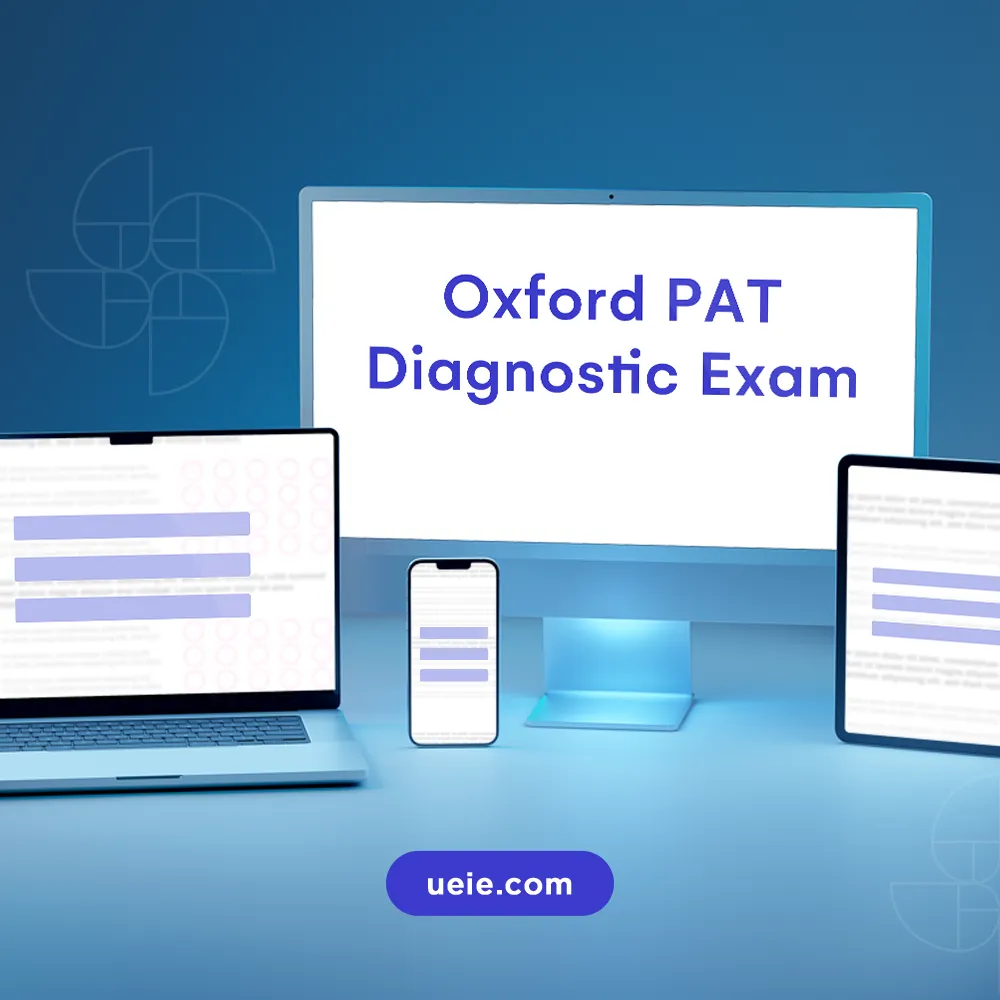
Free Oxford PAT Diagnostic Exam
Test your physics knowledge and math application. Identify areas for focused preparation. This free Oxford PAT diagnostic includes challenging problems and detailed solutions. Get expert feedback from UEIE’s tutors and boost your Oxford application.Note: When using past papers from before 2024 for practice, be aware of their question types. These types, including written sections and non-multiple-choice questions, differ from the current format. Their main value lies in testing knowledge point mastery rather than fully simulating the examination experience.
Simulating a Realistic Environment
- Strictly adhere to the 120-minute time limit.
- Complete the test on a computer to become familiar with screen reading and mouse operation.
- Use only the system-provided online calculator; do not use any personal calculators or consult external materials.
- Choose a quiet, distraction-free environment.
Objective Evaluation and Analysis
- Score yourself objectively based on the marking scheme (multiple-choice questions are typically marked by checking answers).
- Focus on analysing incorrect questions: Was it due to forgotten knowledge points? Unclear concepts? Calculation errors (especially when using the online calculator)? Misinterpretation of the question? Inappropriate multiple-choice strategies?
- Record your weak areas, which will become a focus for subsequent preparation.
4. Set Scientific PAT Score Goals
Combining your target requirements and self-assessment results, you need to set scientific and reasonable preparation goals. It is advisable to follow the SMART principles:
- Specific: Clearly define the PAT score percentage range you aim to achieve (e.g., target above 70%, or strive to reach the average level of admitted students for your target course in previous years).
- Measurable: Your goals should be trackable and measurable through subsequent mock test scores.
- Achievable: Based on your starting point, available time, and anticipated effort, your goals should be attainable through hard work.
- Relevant: Your goals should serve your overall application objective of receiving an interview invitation and, ultimately, an offer.
- Time-bound: Clearly define the deadline for achieving your goals (i.e., the official examination date).
Balancing Ambition with Realism
Goals should be challenging enough to stimulate your potential yet remain realistic. To understand the R-score, a good GCSE background helps alongside the PAT. However, for most students, improving their PAT score is the aspect over which they have the most active control. Remember, the PAT is just one part of the assessment. However, a high score boosts your chances.
5. Adjust Your Mindset and Embrace the Oxford PAT Preparation Challenge
Oxford PAT preparation, especially when adapting to the new format, can present difficulties and setbacks. It is crucial to cultivate a positive mindset:
- Accept the Challenge: View the PAT as an opportunity to enhance your physics thinking, mathematical application, and examination-taking skills.
- Acknowledge the Gap: The purpose of a Diagnostic Exam is to identify problems; the score, whether high or low, merely represents your starting point.
- Focus on the Process: Concentrate on mastering knowledge, improving skills, and optimising strategies.
- Maintain Resilience: Encountering difficult problems or performing poorly in mock tests is normal. The key is to analyse the reasons, learn from the experience, and persevere.
II. Knowledge Base Required for Oxford PAT Preparation
Precisely grasping the knowledge requirements of the PAT is the first step in formulating an effective preparation strategy. You need to know what’s tested, what’s excluded, and how to prepare based on your background.
1. PAT’s Requirements for A-Level Knowledge
The PAT syllabus is based on the UK’s A-Level curriculum but has its specific scope and emphasis:
- Core Scope: Focuses on A-Level Maths Pure topics and AS Physics, plus some A2 Physics content.
- No Further Mathematics: The PAT does not include content from A-Level Further Mathematics. This is to ensure fairness to students who have not studied Further Mathematics. Therefore, there is no need to invest effort in learning Further Mathematics topics specifically for the PAT.
- Depth over Breadth: Although the syllabus may appear concise, the PAT does not simply test the recall of knowledge points. It requires profound understanding of syllabus core physical principles and mathematical tools, and flexible application in novel complex multiple-choice scenarios.
2. Knowledge Alignment for Students from Different Curricula
Students following non-A-Level curricula, such as AP or IB, need to proactively compare and supplement their knowledge:
AP Curriculum Students
- Typically, AP Physics C: Mechanics and AP Physics C: Electricity and Magnetism, or AP Physics 1 and 2, cover most of the PAT Physics syllabus content.
- However, check official PAT syllabus for omissions or differing emphases, e.g., basic astronomy, and cross-reference algebra/trig topics as AP Calculus BC coverage may be incomplete.
IB Curriculum Students
- IB DP Physics HL usually covers the PAT Physics knowledge range well. However, there might be issues with the pace of learning, as some A2 content required for the PAT may be taught later in the IB programme, necessitating early self-study.
- IB Mathematics (AA HL or AI HL) may have different content emphases compared to A-Level Mathematics. Similarly, it is essential to check for and fill any gaps against the PAT mathematics syllabus.
Core Recommendation
Regardless of your curriculum, the most authoritative standard is always the latest examination syllabus released by the PAT authorities. Be sure to download the syllabus, check it item by item, and develop a detailed knowledge supplementation plan to ensure all required content is covered.
3. The Role of Physics Competition Background and Coping Strategies
Competition Advantage
In recent years, the difficulty and style of PAT questions have indeed shown a trend towards those found in physics competitions (such as the British Physics Olympiad, BPhO Round 1). Students with relevant competition experience may have an advantage in handling complex physical scenarios and employing multiple methods to solve problems, and their thinking tends to be more flexible.
Not a Prerequisite
However, it must be emphasised that a physics competition background is by no means a prerequisite for taking the PAT or achieving a good score. The core of the PAT remains the assessment of a profound understanding and application of the knowledge within the syllabus.
Coping Strategies
- For Students with a Competition Background: You can leverage the problem-solving skills and physical intuition developed through competitions. However, you still need to systematically review the PAT syllabus to ensure a solid foundation and practise online multiple-choice questions specifically.
- For Students without a Competition Background: There is no need for anxiety. The focus of your preparation should be on thoroughly understanding the PAT syllabus knowledge and enhancing your physics thinking and mathematical application skills. If time and energy permit, you can engage with some high-quality challenging problems through officially recommended resources (such as Isaac Physics or some past BPhO questions), focusing on learning their problem-analysis methods and thought processes. The aim is to broaden your thinking, not to systematically learn competition-specific knowledge.
III. Core Competencies Essential for High PAT Scores (Under the New Format)
Mastering the knowledge required by the PAT syllabus is fundamental, but this alone is not sufficient to guarantee a high score. Especially with the transition to an online, purely multiple-choice format, you also need to hone the following key core competencies to stand out in the fierce competition.
1. Profound Understanding of Physics Concepts and Physical Intuition
This remains the core of what the PAT assesses. Regardless of how question types change, a deep understanding of fundamental physical concepts and laws is the cornerstone for solving complex problems. You need to:
- Go Beyond Formula Memorisation: Not only memorise formulae but also understand their physical meaning, conditions for applicability, and derivation logic.
- Build Physical Pictures: Be able to quickly translate the scenario described in a question into a clear physical model.
- Cultivate Physical Intuition: Possess a keen insight into physical phenomena, enabling you to quickly identify the crux of a problem and the likely main physical processes involved (sometimes referred to as ‘nous’ or ‘insight’).
2. Solid Application of Mathematical Knowledge and Problem-Solving Skills
A significant number of PAT questions require the application of A-Level mathematical knowledge to analyse and calculate physical problems. You need to possess:
- Proficient Use of Mathematical Tools: Flexibly apply algebraic, geometric, trigonometric, and calculus methods to solve physics calculations.
- Accurate and Swift Calculation: Maintain accuracy and a reasonable speed in calculations under time pressure and without the aid of pen-and-paper derivations (some rough work can be done on paper). Although an online calculator is provided, it is not suitable or efficient for every step.
3. Efficient Strategies and Techniques for Online Multiple-Choice Questions
This is one of the most critical skills under the new format. With 40 multiple-choice questions (including single-best-answer and multiple-answer questions) to be completed in 120 minutes, averaging only 3 minutes per question, mastering efficient strategies is essential:
- Rapid Question Comprehension and Modelling: Quickly grasp the core information of the question, construct the correct physical model, and determine the necessary formulae and methods.
- Option Analysis and Elimination: Utilise physical intuition, dimensional analysis, special values/extreme cases, and estimation to quickly assess the plausibility of options, prioritising the elimination of obviously incorrect distractors.
- Beware of Question Traps and Easily Confused Concepts.
- Addressing Single-Best-Answer and Multiple-Answer Questions: Clearly understand the question’s requirement (select one best answer or all correct answers) and adjust your problem-solving strategy accordingly. Multiple-answer questions require more thorough consideration and verification.
- Time Management and Decision-Making: Quickly assess the difficulty of a question, decisively skip (and mark) challenging problems for which you have no immediate ideas, avoid getting ‘stuck’ on a question, and ensure you complete all questions you are confident about. Learn when to make educated guesses if necessary (there is no negative marking).
4. Proficiency in Using the Online Calculator
Unlike in the past, you must now exclusively use the online calculator provided within the examination system. You need to:
- Familiarise Yourself with its Functions and Limitations: Through the official online practice platform, thoroughly understand the specific functions of the online calculator (such as button layout, order of operations, supported functions) and its limitations.
- Enhance Operational Efficiency: Practise inputting numbers and performing operations quickly and accurately within the online interface to minimise operational errors.
- Judge When to Use it Appropriately: Balance the use of the online calculator, mental arithmetic, and paper-based rough calculations, choosing the most efficient method to complete calculation tasks and avoiding unnecessary time spent on operations.
5. Ability to Adapt to the Online Examination Environment and Screen Reading
Engaging in high-intensity mathematical and physical thinking whilst looking at a screen for an extended period tests concentration and stamina. You need to:
- Familiarise Yourself with the Examination Interface: Through official online practice tests, become accustomed to the Pearson VUE examination interface, question presentation format, option selection method, flagging function, time display, etc.
- Improve Screen Reading Efficiency: Practise reading complex physics and mathematics questions containing diagrams or special symbols on a screen, maintaining focus and accuracy of comprehension.
- Coordinate Online and Offline Operations: Efficiently switch between screen reading, online calculator operation, and using paper for rough derivations and calculations.
IV. Core Oxford PAT Preparation Strategies and Resource Utilisation (Under the New Format)
Clear strategies and the effective use of resources are key to efficient PAT test preparation. This requires a phased, focused process that is fully adapted to the new online multiple-choice format.
1. Core Principle: Understanding-Based, Proficient Application, Adaptation to Computer-Based Testing
- Profound Understanding is a Prerequisite: The PAT does not simply test knowledge recall but deeply assesses physical understanding and mathematical application skills. The core of preparation should lie in building a profound understanding of the concepts and principles within the syllabus.
- Proficient Application is Key: Building on understanding, you need to transform knowledge into the ability to solve problems quickly and accurately in the online multiple-choice format through extensive high-quality practice.
- Adaptation to Computer-Based Testing is a Safeguard: Preparation must be tailored to the characteristics of the online examination, including familiarisation with the interface, practice with the online calculator, and the ability to efficiently read and think about physics and mathematics problems on screen.
2. Phase 1: Knowledge Organisation and Foundation Consolidation (Early Preparation)
Objective
Systematically review the physics and mathematics knowledge points covered by the PAT syllabus, ensure there are no blind spots, achieve a profound understanding of core concepts, and reinforce the precision of basic calculations.
Actions
- Referencing the latest official syllabus, organise knowledge modules one by one.
- Practise basic calculations and typical example problems, especially simulating an environment where you rely minimally on pen and paper (using scrap paper for auxiliary thinking).
- Use A-Level textbooks, reliable online resources (such as relevant sections of MEI, Khan Academy), or systematic courses, like UEIE’s Oxford PAT Video Lecture Series, for learning or consolidation.
Resources

ESAT & PAT Video Lecture Series
Developed by renowned Oxbridge tutor Xie Tao, the ESAT & PAT Video Lecture Series offer a comprehensive guide to mastering both exams. Access expert video instruction covering Maths, Physics, specialised PAT preparation, and proven strategies for top scores.US$282 – US$1 136Price range: US$282 through US$1 136
3. Phase 2: Specialised Training and Skill Enhancement (Mid-Preparation – Crucial Stage)
Objective
Undertake specialised training focused on the characteristics of PAT online multiple-choice questions to improve problem-solving speed, accuracy, application of multiple-choice strategies, efficiency in using the online calculator, and adaptability to the online environment.
Actions
- Thoroughly Study Official Resources: Prioritise using the online practice tests/sample questions provided by the University of Oxford, as this is the best way to familiarise yourself with the real interface and question types.
- Targeted Breakthroughs: Engage in extensive, targeted online multiple-choice question practice (especially multiple-answer questions). You can utilise the Isaac Physics platform and UEIE’s Oxford PAT Practice Question Bank (online) for specialised practice and gradually adapt to the online answering format.
- Strengthen Core Competencies: Deliberately practise the various core competencies mentioned in the previous section, such as multiple-choice techniques (elimination, estimation, special values, etc.), rapid and accurate operation of the online calculator, and screen reading concentration. Conduct timed training.
- Resource Utilisation: The official sources only provide past papers without solutions. Furthermore, past papers from before 2024 are not entirely in a multiple-choice format, so they need to be used selectively. However, these past papers can still be used to test understanding and application of knowledge points. When practising, try to convert their thought processes into multiple-choice solutions or judgments.
Resources
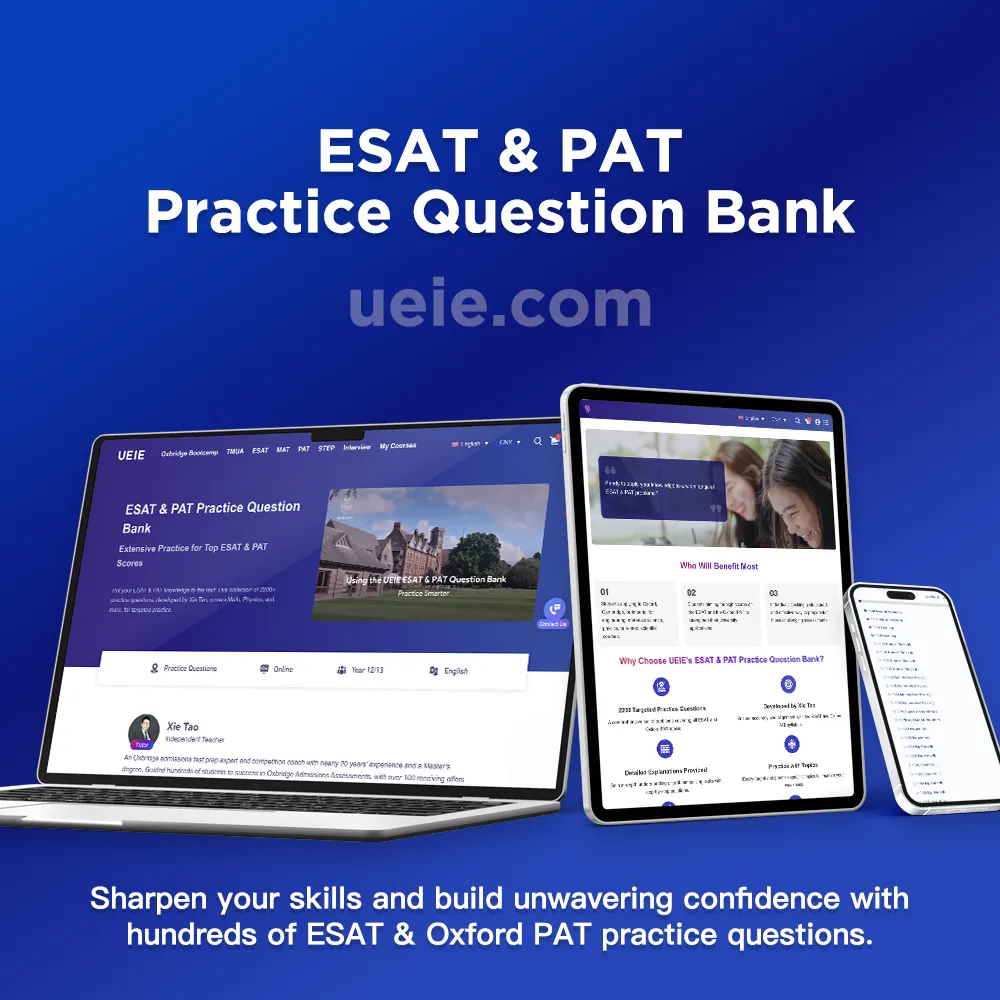
ESAT & PAT Practice Question Bank
Ace the ESAT & Oxford PAT with targeted practice question bank! Our 1600+ practice questions cover all major topics in Maths 1, Maths 2, and Physics. Improve your understanding and master key concepts.US$1 036Original price was: US$1 036.US$868Current price is: US$868.4. Phase 3: Online Simulation and State Adjustment (1-2 Months Before the Exam)
Objective
Comprehensively simulate the real online examination environment, assess overall preparation levels, optimise examination strategies (time allocation, answering pace), identify and rectify weaknesses, and adjust to an optimal examination state.
Actions
- Strict Full-Length Mock Exams: Use the latest official online practice tests (if complete sets are available) or high-quality online full-length mock exam papers, such as UEIE’s Oxford PAT Full-Length Mock Exams, which include 4 original online mock papers, for rigorous simulation.
- Simulation Requirements: Strictly adhere to the 120-minute time limit; complete on a computer; use only the online calculator; ensure a quiet, distraction-free environment. It is recommended to complete at least 3 high-quality mock exams.
- Strategy Rehearsal: In mock exams, practise time allocation (average 3 minutes/question, how to reserve time for checking), strategies for dealing with difficult questions (marking, skipping, guessing), and procedures for the checking phase.
- In-depth Review and Adjustment: After each mock exam, carefully analyse the reasons for incorrect answers, review time allocation, summarise lessons learnt, and address knowledge or skill shortcomings in a targeted manner. Adjust your mindset and build confidence.
Resources
5. Core Recommendations for Selecting Preparation Resources
- Official Resources First: Always prioritise PAT information published by the University of Oxford. Core resources include the PAT syllabus, official online practice tests/sample questions, past papers, official annual reports and preparation advice, and course materials.
- Systematic Support: Consider using systematic PAT preparation resources, such as those provided by UEIE (video courses, Practice Question Bank, full-length mock exams). These materials are based on the many years of teaching experience of expert tutors, integrated and optimised to effectively supplement official resources and improve preparation efficiency.
- Selective Expansion: Based on individual needs, selectively use other high-quality supplementary resources, such as the Isaac Physics website, BPhO Round 1 past papers, etc. Avoid an overabundance of resources, which can dilute focus and energy. Quality over quantity.
- Active Learning: For any resource, engage in active thinking, in-depth review, and summarisation to internalise it into your own abilities.
Resources

ESAT & PAT On-Demand Prep Suite
The ESAT & PAT On-Demand Prep Suite, developed by Xie Tao, is your all-in-one solution for exam success, which includes video lectures covering Maths, Physics, over 1600 practice questions with detailed solutions, and full-length mock exams for ESAT Maths 1, Maths 2, Physics, and the Oxford PAT. Prepare thoroughly and maximise your score.US$609 – US$2 416Price range: US$609 through US$2 416
V. How to Plan Your Oxford PAT Preparation Time?
‘How long does Oxford PAT preparation take?’ This is a question many students are concerned about. The scope of knowledge for the PAT is relatively concentrated, but its demands on physics thinking, mathematical application, and adaptation to the new online multiple-choice format also require ample time for preparation and refinement. Sensible planning is key to success.
1. Core Influencing Factors
The amount of preparation time you need primarily depends on the following factors:
- Target Score: Aiming for top-tier scores (e.g., 75+) usually requires longer and more detailed refinement than reaching the average interview threshold (e.g., 60+).
- Starting Level: Your current foundation in physics and mathematics, and the gap between your core competencies and PAT requirements.
- Available Time: How many hours per week you can consistently dedicate to efficient preparation.
- Learning Efficiency: The speed at which you absorb knowledge and master skills, and the effectiveness of your methods.
2. Recommended Oxford PAT Preparation Periods for Different Starting Points
The following are general recommendations based on common student backgrounds. Please note these are only references; consistent and effective effort is more important than sheer duration:
Students with a Solid Physics/Mathematics Foundation (with experience in mathematics or physics competitions):
- Focus: Adapting to the specific PAT syllabus, online multiple-choice style, time pressure, and the online calculator.
- Recommendation: Begin targeted training approximately 3-4 months before the examination (e.g., start in late June or early July for an October exam).
A-Level Curriculum Students (without competition experience):
- Focus: Consolidating physics and mathematics foundations, engaging in extensive online multiple-choice practice to improve speed, accuracy, and strategy, and fully adapting to the online examination environment.
- Period: It is advisable to start systematic preparation no later than 4-6 months before the examination (e.g., begin in May or early June). You will need to go through a complete cycle of ‘knowledge consolidation → specialised online practice → online mock exam sprint.’
AP/IB Curriculum Students (without competition experience):
- Focus: In addition to the challenges faced by A-Level students, extra time is needed for identifying and addressing knowledge gaps (by comparing with the PAT syllabus). More time may also be required to adapt to the A-Level system’s question style and the online examination mode.
- Period: It is strongly recommended to start earlier, ensuring at least 5-6 months or even longer for preparation (e.g., late April or early May, or even earlier).
Core Tip
Starting early always offers an advantage, allowing for a more composed approach to each preparation phase. The key lies in consistency and learning efficiency.
3. Balancing Preparation with Daily Academic Work: Practical Tips
For students currently in school, efficiently balancing Oxford PAT preparation with coursework is crucial:
- Fixed Schedule: Incorporate PAT test preparation into your weekly study timetable as if it were a formal subject.
- Utilise Holidays: Use weekends and school holidays (especially the summer break) for concentrated knowledge review, tackling difficult areas, or simulation training.
- Focused Efficiency: During allocated PAT study periods, maintain high concentration and strive for efficiency per unit of time.
- Flexible Adjustments: During busy periods such as school examinations or the application season, you can appropriately adjust the intensity of PAT preparation but try to maintain a certain amount of practice to keep your ‘hand in.’ Catch up promptly afterwards.
- Work-Life Balance: PAT preparation is a marathon. Ensure adequate sleep and moderate relaxation to avoid fatigue, which can lead to decreased efficiency and burnout.
VI. Common PAT Preparation Misconceptions and Countermeasures (Under the New Format)
1. Misconception 1: Starting Too Late, Lack of Planning
Manifestation and Consequences
Underestimating the demands of the PAT on physics and mathematics abilities, particularly the time required to adapt to the online multiple-choice format, and only starting to prepare hastily close to the examination. This leads to an unstable foundation, insufficient practice, and an inability to adapt to the examination rhythm.
Countermeasure
Plan early, invest consistently! Recognise that Oxford PAT preparation (especially skill enhancement and adaptation to the new format) requires accumulated time. Refer to the recommendations in Section V, formulate a detailed, phased preparation plan, and ensure consistent, effective study input each week.
2. Misconception 2: Neglecting Online Platform Features, Disconnect Between Practice and Actual Exam
Manifestation and Consequences
Relying mainly on paper-based practice, lacking familiarity with the Pearson VUE online examination platform’s interface and operational methods (such as flagging, navigation), and the use of the online calculator (functionality, speed, precision); not being accustomed to prolonged screen reading and answering.
Countermeasure
- Frequently use official online practice tests: This is the best way to familiarise yourself with the real environment and must be used repeatedly.
- Specific practice with the online calculator: Train this as an independent skill to achieve proficiency, speed, and accuracy.
- Simulate the online environment: Conduct daily practice and mock exams on a computer as much as possible to cultivate screen reading stamina and concentration.
3. Misconception 3: Lack of Effective Multiple-Choice Strategies and Techniques
Manifestation and Consequences
Treating multiple-choice questions as simple knowledge checks, lacking coping techniques; being prone to errors when facing distractors; not differentiating strategies for single-best-answer and multiple-answer questions; poor time allocation, spending too much time on difficult questions or working too slowly (far exceeding the average of 3 minutes per question).
Countermeasure
- Systematically learn techniques (elimination, estimation, extreme cases, dimensional analysis, etc.).
- Undertake extensive timed multiple-choice training to improve speed and accuracy.
- Summarise problem-solving approaches for different types of multiple-choice questions (physics concept discrimination, calculation, comprehensive application).
- Practise time management and trade-off strategies (when to skip, when to guess) in mock exams.
4. Misconception 4: Weak Grasp of Knowledge or Unskilled Application
Manifestation and Consequences
Having a superficial understanding of basic concepts and formulae within the syllabus, relying on rote memorisation; being unable to flexibly apply knowledge to question scenarios, and struggling to find a solution path even for multiple-choice questions.
Countermeasure
- During the initial preparation phase (Phase 1), ensure a solid grasp of fundamental knowledge, understanding physical principles and mathematical methods.
- During practice (Phase 2), do not just check answers; review the problem-solving process, consider how knowledge points are applied, and try to find multiple solutions to a single problem.
5. Misconception 5: Unbalanced Mindset, Improper Stress Management
Manifestation and Consequences
Feeling excessively anxious about the difficulty, time constraints, or online format of the PAT; being prone to mental breakdown and self-doubt when encountering setbacks (such as unsatisfactory mock exam results or inability to solve difficult problems), affecting the continuity of preparation.
Countermeasure
- Set reasonable, achievable goals (refer to Section I).
- Accept that challenges and setbacks are a normal part of preparation; focus on your own progress rather than making blind comparisons.
- Practise thinking under pressure, maintain a moderate level of tension, and avoid excessive anxiety.
- Balance work and rest to ensure the sustainability of your preparation.
6. Misconception 6: Misuse of Resources or Lack of Information
Manifestation and Consequences
Relying on outdated or unsuitable preparation materials for the new format (e.g., only using old paper-based past papers); not paying attention to the latest information released by official sources (such as syllabus updates, sample questions, online test updates); blindly collecting numerous resources without knowing how to use them effectively, leading to dispersed energy.
Countermeasure
- Focus on the latest information and online preparation resources released by the University of Oxford as your core materials.
- Critically use past papers (mainly for content understanding, not format simulation).
- Selectively use high-quality supplementary resources that match the current examination format (such as Isaac Physics, UEIE series materials, etc.).
- Quality over quantity in resources; focus on using core materials deeply and thoroughly.
VII. Final Words: Mindset and Action
By now, you should have a systematic understanding of how to prepare for the PAT test in its new format. As I conclude this guide, allow me to re-emphasise the importance of mindset and outline the key actions for you to take next.
1. Embrace the Challenge: Essential Preparation Mindset
The Oxford PAT preparation journey is inevitably filled with challenges. A strong psychological constitution is a key guarantee for reaching your goal. Please be sure to cultivate the following mindsets:
- Face Setbacks, Build Resilience: Encountering difficult problems, performing poorly in mock exams, or struggling with online operations are all normal occurrences. The key is to view them as opportunities to identify problems, learn lessons, and improve yourself.
- Focus on Deep Work, Maintain Consistent Effort: The improvement of physical intuition and problem-solving skills is not achieved overnight. Ensure high-quality, continuous study input to achieve gradual progress.
- Maintain Equanimity, Balance Mind and Body: Focus on your own progress, learn to manage the additional stress that online examinations may bring, balance work and rest, and ensure the sustainability of the preparation process.
- Find Joy in It, Drive Perseverance: Try to discover the joy in tackling challenging physics and mathematics problems and appreciate their logical beauty. When you can enjoy the process, perseverance will become more natural and enduring.
2. Action Speaks Louder Than Words: Next Step Recommendations
Having clarified your mindset and methods, the next crucial step is to translate cognition into tangible action. I recommend that you:
- Act Immediately: Based on the advice in this guide, refine and execute your preparation plan.
- Utilise Resources Wisely: Use official materials as your core and efficiently leverage selected supplementary resources.
- Practise and Reflect Continuously: Persist with high-quality practice and regularly review, summarise, and adjust.
Finally, please believe in yourself. Thorough preparation and a positive mindset will be your most powerful weapons in tackling the PAT challenge. I wish you success in conquering the PAT through your wisdom and hard work, and in entering the academic institution of your dreams!
-

Oxford PAT Uncovered: Policy, Syllabus & Key Focus Areas

The Oxford PAT Test (Physics Aptitude Test) is a crucial entrance examination used by the University of Oxford to assess the overall physics and mathematical ability of undergraduate applicants for its Physics, Engineering Science, and Materials Science programmes. It focuses on evaluating candidates’ ability to solve problems using physics principles and mathematical tools. For students targeting these programmes, a thorough understanding of the Oxford PAT (especially its latest online format) requirements, content, and assessment methods is vital. To help those planning to apply for 2026 entry accurately grasp the latest exam situation, this article will provide a comprehensive and authoritative interpretation.
After gaining a detailed understanding of the Oxford PAT overview, it is recommended to continue reading my (Mr. Xie Tao’s) series of articles: Oxford PAT Preparation Guide and Oxford PAT Registration Guide, for detailed preparation strategies and registration guidance.
I. Latest Updates on Oxford PAT Test
The PAT test has undergone significant adjustments in recent years. Understanding these core changes, which have been implemented and will continue for the 2025 examination cycle (for 2026 entry), is crucial for preparation.
1. Oxford PAT Test Organisation and Implementation
From 2024 onwards, the University of Oxford has appointed Pearson VUE as the global implementing body for the PAT and other entrance examinations, responsible for test centre arrangements and online testing. However, the examination papers are still set by the Oxford University Physics Department, ensuring the authority and continuity of the exam content and assessment standards.
2. Key Changes
- Fully Online Computer-Based Test: The PAT test has completely transitioned to an online format, conducted at Pearson VUE certified test centres, no longer using paper scripts.
- Question Type Adjustments: All examination questions are now multiple-choice. According to the 2024 papers and official sample questions, this includes both Single Choice and Multiple Choice/Multiple Response formats. The number of questions has also increased to 40.
- Scoring Method: The total mark for the entire paper remains 100, but the 40 multiple-choice questions have unequal values (possibly 2, 3, or 4 marks).
- Calculator: The test system will include an online digital calculator. Candidates must use this online calculator, and bringing or using any personal calculator is strictly prohibited.
II. Who Needs to Take the PAT Test? (For 2026 Entry)
The Oxford PAT is a mandatory entrance examination for applicants to the following specific undergraduate (or integrated Master’s) programmes at the University of Oxford, It must be taken and typically cannot be substituted with other examinations:
Courses UCAS Code Engineering Science H100 Biomedical Engineering H811 Chemical Engineering H800 Civil Engineering H200 Electrical Engineering H620 Information Engineering H630 Mechanical Engineering H300 Materials Science FJ22 Physics F303 Physics and Philosophy VF53 III. Oxford PAT Key Dates
Event Date / Timeframe Notes / Reminders Registration Time 18 June to 19 September 2025 Requires creating an account via the Oxford official website. Test Slot Registration 18 August to 26 September 2025 Must complete Pearson VUE test slot booking before this date. Test Dates 22 October 2025 (Wednesday) and 23 October 2025 (Thursday) Choose a specific test session in the Pearson VUE system. Interview Invites November to December 2025 Sent via email after the University of Oxford completes initial screening. Results Access January 2026 Issued to candidates via the examination registration platform (or email). Important Note: All dates (especially the specific start and end times for registration) are subject to change. Please regularly visit the Oxford PAT page on the University of Oxford Admissions website and the Oxford Admissions Testing page on Pearson VUE’s website for the most authoritative official information.
IV. PAT Test Format and Structure
Since 2024, the Oxford PAT test has adopted a new online format and question structure.
Item Details Test Mode Online Computer-based Test Test Location Global Pearson VUE Certified Test Centres Duration 2 hours (120 minutes) Questions 40 multiple-choice questions (including Single Choice and Multiple Choice) Calculator On-screen calculator provided, no personal calculators allowed Formula Sheet Not Permitted Dictionary Not Permitted Key Points of Interpretation:
- Pure Multiple-Choice Format: This is the biggest change. Preparation strategies need to focus more on techniques for solving multiple-choice questions, the ability to quickly judge and differentiate between distractors, as there are no marks for showing working. The coexistence of single and multiple-choice questions adds complexity.
- Online Computer-Based Test and Calculator: Candidates must adapt to the online testing environment and become proficient in using the online calculator provided by the system. They cannot rely on their familiar personal calculators.
- Time Pressure: Completing 40 physics and mathematics multiple-choice questions in 2 hours means an average of only 3 minutes per question, requiring high speed and efficiency in problem-solving.
- Knowledge and Memory: Formula sheets are not allowed, meaning candidates need to firmly memorise all relevant formulas and physical constants within the syllabus.
V. Oxford PAT Scoring Mechanism and Score Interpretation
Understanding how the Oxford PAT test is scored and what the scores represent is crucial for evaluating your competitiveness and setting preparation goals.
1. Scoring Method
- Total Score and Composition: The maximum score for the PAT is 100. The score is entirely derived from the 40 multiple-choice questions (including single and multiple-choice).
- Question Values: The value of each multiple-choice question is not equal and may be weighted differently based on difficulty or other factors (e.g., possibly 2, 3, or 4 marks).
- Scoring Characteristics: Incorrect answers do not incur penalties, encouraging candidates to attempt all questions. The final score is the sum of the marks for correct answers.
2. Score Report
- Internal Use: Oxford University admissions tutors receive all applicants’ PAT scores directly in November, which are used in conjunction with other application materials (such as the cGCSE mentioned below) for interview shortlisting.
- Candidate Access: Candidates can usually only access their specific PAT scores through the examination registration platform after receiving their final application result from the University of Oxford in January of the following year (i.e., January 2026).
3. Score Interpretation and Competitiveness Analysis
Understanding the relative competitiveness of PAT scores is very important, but please note that Oxford University does not set fixed ‘interview score cut-offs’ or ‘admission score cut-offs’. Admission decisions are always based on a comprehensive assessment of all aspects of an applicant’s materials.
Application of R-Score
In recent years (including the 2024 application cycle), the Oxford Physics Department has primarily used the R-score for interview shortlisting. This score combines the PAT score with a contextualised GCSE score indicator called cGCSE:
R-score before interview (%) = PAT score (%) + 10 x cGCSE
Here, cGCSE is a standardised score that measures a student’s GCSE (or IGCSE) performance relative to the context of their school, typically ranging from -3 to +3. Applicants lacking GCSE information (such as some international students) are assigned a neutral score of 0.
Note: There was a subtle but important change in calculating the R-score in 2024: all negative cGCSE scores were ignored in the calculation. This was undoubtedly a significant advantage for students who did not achieve enough A* (8/9) grades in their GCSE or IGCSE subjects.
Interview Shortlisting Threshold
The interview shortlisting threshold varies each year. The blue line in the diagram below represents the interview shortlisting threshold from 2006-2024. For example, applicants with an R-score of 70% or higher in 2024 were automatically included in the interview shortlist. Some candidates with an R-score slightly below this threshold might also be invited for an interview if they had other outstanding background information or special circumstances (including technical issues encountered during the exam).
PAT Score Competitiveness Analysis
- Average Level: The average PAT score for all applicants in the 2024 examination was approximately 49.6% (significantly lower than the 55.6% in 2023). This may be related to the difficulty of the questions in that year, the first time a fully new format was adopted, or disruptive factors during the examination.
- More Competitive: A PAT score of generally above 65% is considered to significantly increase the chances of being invited for an interview.
- Strongly Competitive: A score of 75% or higher is considered a highly competitive score.
- Lower Scores: Scores below 65% generally make it more difficult to secure an interview, unless there are very strong other application highlights or supporting background factors.
Note that since 2024 was the first year the pure multiple-choice online format was used, and the report for that year mentioned disruptive factors, direct comparison with scores from previous years should be done with caution.
After the interview, the final R-score after the interview is calculated based on the PAT score, cGCSE score, and interview score:
R-score after interview = PAT score (%) + 10 x cGCSE + 2 x interview score (%)
Final Admission
The R-score after the interview, calculated through a series of weighted calculations, carries significant weight in the admission decision. However, it is not the only factor influencing the outcome. The Oxford Physics Department will also comprehensively consider other materials such as recommendation letters and personal statements before making the final decision on whether to admit a candidate.
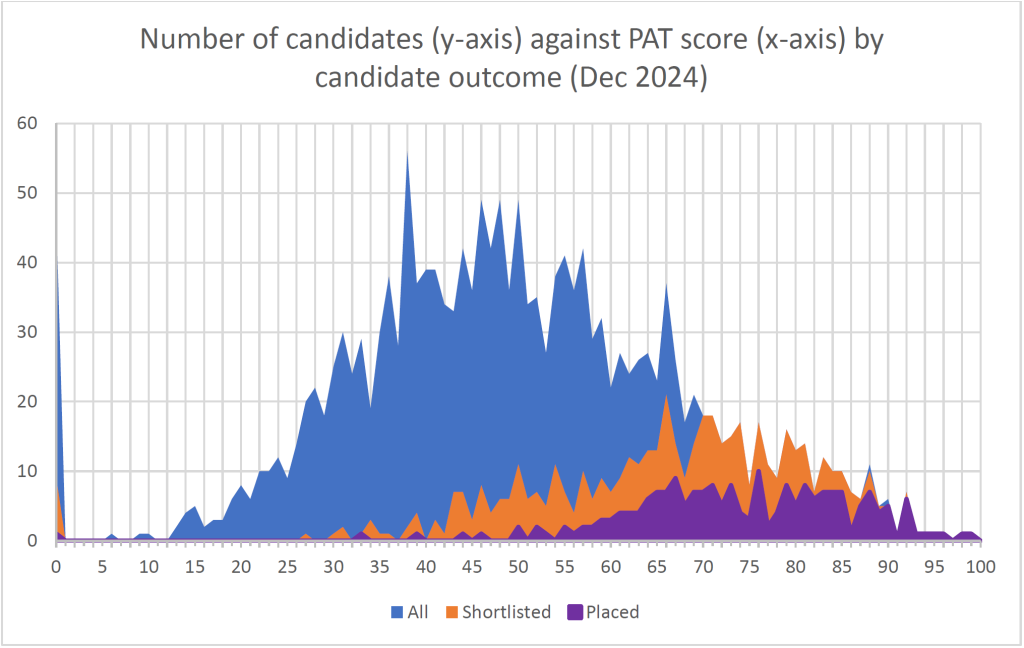
Distribution of PAT Scores and the Number of Admitted Students Published by the Oxford Physics Department in 2024
VI. PAT Test Syllabus and Difficulty Analysis
Accurately understanding the scope and difficulty characteristics of the Oxford PAT is fundamental to developing an effective preparation plan.
1. Syllabus Scope and Version
- Knowledge Base: The PAT syllabus covers the core knowledge points of A-Level Mathematics and AS Physics, as well as some A2 Physics. It is particularly important to note that the syllabus explicitly does not include content from A-Level Further Mathematics.
- Syllabus Version: The current PAT test syllabus is still based on the version revised in 2018. Although the test format has changed, the scope of knowledge remains essentially the same.
2. Syllabus Characteristics
- Concise but In-depth: The official PAT syllabus is very condensed, with the entire content being less than 2 pages of A4 paper. Its design philosophy is not to pursue breadth of knowledge, but rather to deeply examine students’ depth of understanding and ability to apply core physics principles and mathematical tools based on the common foundation of high school curricula in various countries.
- Physics and Mathematics Integration: Questions often tightly integrate physics scenarios with mathematical methods, assessing the ability to apply knowledge comprehensively to solve problems.
3. Knowledge Point Overview
According to the official syllabus, the main areas of examination include:
Mathematics Section
- Basic Mathematics: Arithmetic, Geometry (including coordinate geometry), basic Probability.
- Algebra: Polynomials (including solutions to quadratic equations, factorisation), Inequalities, Graphs of Functions (including transformations, finding stationary points using derivatives), Trigonometric Functions (basic relationships), Indices and Logarithms, Sequences and Series (sum of arithmetic and geometric series), Binomial Theorem (positive integer indices).
- Calculus: Differentiation and Integration of Polynomials (including negative and fractional indices), using differentiation to find gradients/extrema, using integration to find areas, simplifying integrals using symmetry.
Physics Section
- Mechanics: Kinematics (distance, velocity, acceleration, SUVAT equations), Newton’s Laws, Circular Motion, Common Forces (gravity, friction, tension, etc.), Moments, Energy and Momentum (conservation laws, work, power), Springs (Hooke’s Law, elastic potential energy).
- Waves and Optics: Basic properties of waves (transverse/longitudinal waves, amplitude, frequency, wavelength, wave speed), Electromagnetic Spectrum, Reflection and Refraction (Snell’s Law), Interference and Diffraction (concepts), Standing Waves (basic concepts).
- Electromagnetism: Basic Circuits (current, voltage, resistance, Ohm’s Law, series and parallel circuits, power), Electric Fields (force between point charges, force on a charge in a uniform electric field), Magnetic Fields (basic concepts, possibly involving simple applications such as Lorentz force, see syllabus for details), Photoelectric Effect (concept).
- Modern Physics and Astronomy: Atomic Structure (Rutherford model, Bohr model), Solar System Objects (basic knowledge of planets, moons, comets, etc.), Orbital Motion (speed, period, centripetal force/acceleration in circular orbits, involving universal gravitation).
- Thermodynamics: Not included in the 2018 version of the Oxford PAT syllabus, and there have been no thermodynamics questions in the last five years.
4. Understanding ‘Beyond Syllabus’ Questions and Difficulty Analysis
Understanding ‘Beyond Syllabus’
So-called ‘beyond syllabus’ questions in the PAT typically do not test knowledge points outside the syllabus. Instead, they involve applying knowledge from within the syllabus in novel or unfamiliar ways, or they might cover physical models or ideas commonly seen in physics competitions but only briefly touched upon at A-Level. For these types of questions, necessary background information or formulas are often provided in the question.
Difficulty Characteristics
- Higher than A-Level: The PAT demands a depth of thinking, physical intuition, and mathematical application ability far exceeding that of standard A-Level examinations.
- Compared to MAT/STEP: Compared to MAT (primarily pure mathematics), the PAT requires proficiency in both physics and mathematics; compared to STEP (focusing on higher-level pure mathematics proofs), the mathematical difficulty of the PAT is lower, but the application of physics and integrated requirements are higher.
- Impact of Pure Multiple-Choice Questions: Following the reform to pure multiple-choice questions, although there is no opportunity to demonstrate detailed working, the requirement for accuracy in conceptual differentiation, rapid modelling and estimation skills, and multiple-choice strategies (including handling multi-select questions) is higher.
- Difficulty Level Reference: The average PAT scores in recent years (e.g., approximately 49.6% in the 2024 exam ) are generally not high, and scores fluctuate significantly (the average score in 2024 showed a notable decrease compared to 2023). This reflects the high challenge of the examination itself. Achieving a high score requires a solid foundation and excellent comprehensive ability.
VII. How to Register for the Oxford PAT Test?
Registering for the Oxford PAT primarily involves creating an account on the University of Oxford’s official website, linking your application information, and then completing the specific test centre and examination time booking through the Pearson VUE platform.
The specific registration steps, required information, test centre selection, fee details, special requirements applications, and detailed guidance for candidates from different regions are all very important and may involve many details.
For the most complete and accurate step-by-step guidance, please refer to our specially prepared detailed guide:
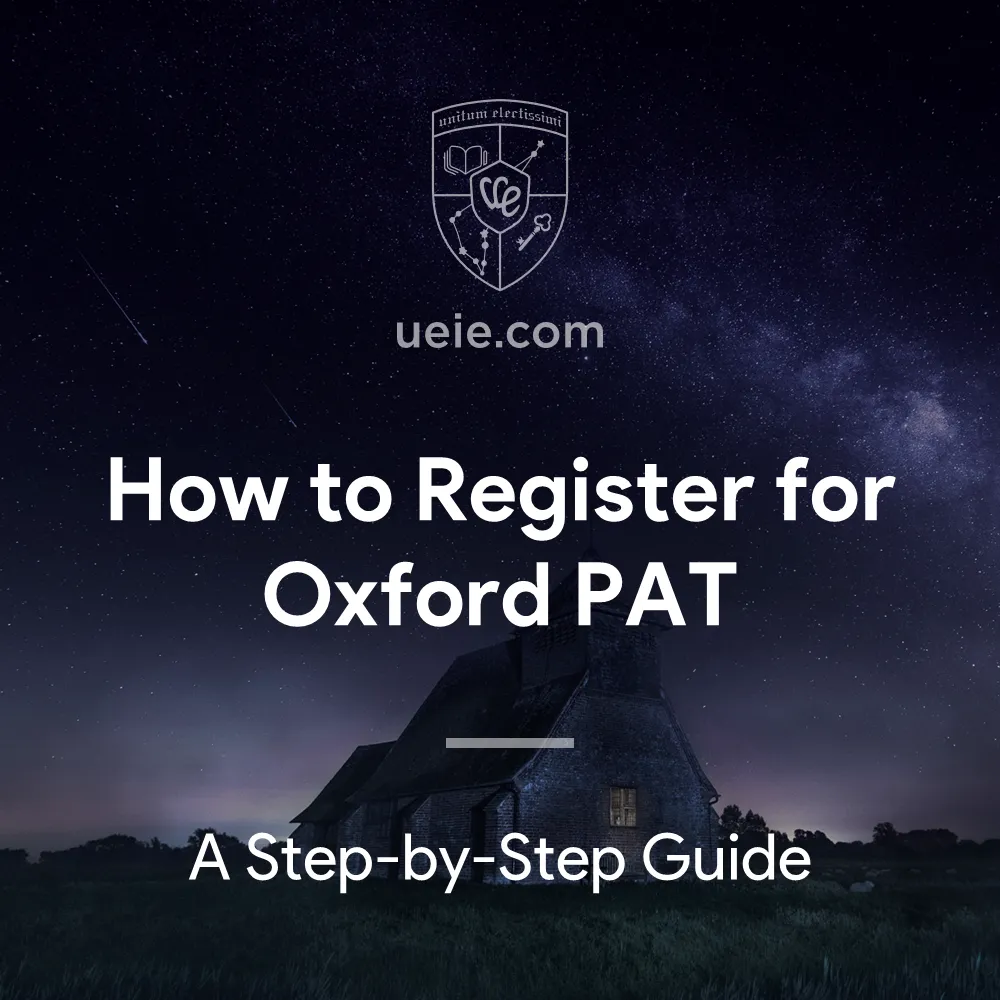
How to Register for Oxford PAT
Register for the Oxford PAT with our simple 4-step guide and get closer to achieving your Oxford dream!VIII. Core Preparation Strategies and Resource Recommendations
Effective preparation not only requires understanding the examination itself but also clarifying the preparation direction and making good use of high-quality resources.
1. Overview of Core Preparation Strategies
The core of PAT preparation lies in a solid foundation of physics and mathematics knowledge, strong problem-solving skills, and adapting to the pure multiple-choice online examination format. Preparation should focus on:
- Consolidating Foundation: Ensuring a deep understanding of all physics and mathematics concepts within the syllabus.
- Improving Application: Training the ability to apply foundational knowledge to complex and unfamiliar situations.
- Practice Strategies: Mastering the techniques for answering multiple-choice questions (including single and multiple-select) and time management.
- Familiarising with the Platform: Adapting to the online examination environment and the use of the online calculator.
For detailed preparation plans, phased training methods, targeted skill enhancement techniques, etc., please be sure to read my specially authored:

Ace the Oxford PAT: Mastering Maths, Physics & Online Test Skills
Aiming to ace the Oxford PAT test? This guide helps you master the essential Maths and Physics syllabus, develop crucial online test-taking skills (MCQ strategies, online calculator proficiency), and build a solid preparation plan for success in Physics or Engineering.2. Official Core Preparation Resources
The official website of the Oxford University Physics Department is the primary platform for obtaining the most authoritative PAT preparation information and materials. All candidates are strongly advised to make full use of the abundant resources it provides:
- Examination Syllabus: Clearly defines the scope of the examination (currently still the 2018 version).
- Past Papers: Provides a large number of past test papers. Note: Pre-2024 papers had different formats. They included written tests and non-multiple-choice questions. But their content and difficulty remain highly valuable. These help understand syllabus requirements and needed abilities.
- Official Online Sample Questions/Practice Tests: The official website or Pearson VUE provides sample questions or practice tests simulating the new online multiple-choice format. It is highly recommended to use these to familiarise yourself with the examination interface and online calculator.
- Annual Reports: Provide important information such as statistical data, average scores, and screening processes from previous years.
- ‘Preparing for the PAT’ Online Course: A free online preparation support programme provided by the Oxford Physics Department, including problem sets, videos, lectures, etc..
3. UEIE Oxford PAT Preparation Resources
I help candidates prepare for PAT systematically. My courses build on years of teaching research. I continuously update preparation materials. This year’s new self-study package includes:
- Oxford PAT Video Lecture Series: Includes in-depth explanation of exam points and accompanying PDF textbooks.
- Oxford PAT Practice Question Bank: Offers an extensive range of topic-based practice questions, designed to supplement the limited number of official past papers and strengthen problem-solving skills.
- Oxford PAT Full-Length Mock Exams: Four full-length simulation papers, featuring entirely original or adapted questions that do not reuse past paper content. These are ideal for refining your exam strategy and ensuring you are in peak condition before the test.
Click to learn more about UEIE PAT preparation resources:

ESAT & PAT On-Demand Prep Suite
The ESAT & PAT On-Demand Prep Suite, developed by Xie Tao, is your all-in-one solution for exam success, which includes video lectures covering Maths, Physics, over 1600 practice questions with detailed solutions, and full-length mock exams for ESAT Maths 1, Maths 2, Physics, and the Oxford PAT. Prepare thoroughly and maximise your score.US$609 – US$2 416Price range: US$609 through US$2 416
4. Other Supplementary Resources
Based on official Oxford recommendations and preparation needs, the following can be selectively used:
- Isaac Physics: Provides a large number of high-quality physics and mathematics problems.
- British Physics Olympiad (BPhO) Past Papers: The style of questions helps develop the ability to solve challenging problems.
- Other Online Platforms or Books: Such as resources compiled by Physics & Maths Tutor (PMT), some physics/mathematics thinking training books, etc..
5. Core Recommendations
It is crucial that official resources form the core of your preparation, especially past papers (bearing in mind the changes in format) and the online practice tests. Depending on your individual needs, carefully select high-quality supplementary materials (such as UEIE’s systematic preparation plans or other officially recommended websites) to support your systematic learning and targeted practice. Finally, ensure you utilise the official Pearson VUE online practice tests to familiarise yourself thoroughly with the computer-based testing environment and the online calculator.
IX. Suggested Next Steps
After reading this Oxford PAT Comprehensive Guide, you should have a clear grasp of the key information about this test. To translate this understanding into effective application preparation, we recommend that you take the following actions immediately:
1. Verify Official Requirements
Revisit the official University of Oxford admissions website (especially the pages for Physics, Engineering Science, Materials Science, and other relevant departments) to carefully confirm the latest and most accurate admission requirements for 2026 entry, including whether the PAT is still mandatory and the specific programmes it applies to.
2. Plan Your Exam Registration
Consult the detailed Oxford PAT Registration Guide to understand the registration process, deadlines, and required materials.
Remember the official start and end dates for registration and be sure to complete all registration and Pearson VUE test slot booking steps before these dates.
3. Develop a Preparation Plan
Read the Oxford PAT Preparation Guide and develop a systematic, personalised preparation timetable and learning strategy based on your own circumstances (physics and mathematics foundation and available time). Start preparing as early as possible; PAT preparation requires a comprehensive and in-depth improvement of physics and mathematics abilities.
4. Select and Utilise Resources
- Make good use of official core resources: Download and study the latest examination syllabus, past papers (noting format changes), online sample questions, and preparation course materials provided on the Oxford Physics Department official website.
- Selective supplementary: Based on your preparation plan, carefully select high-quality supplementary resources, such as UEIE’s PAT preparation lectures and materials, or other officially recommended practice platforms, for systematic learning and targeted training.
- Familiarise yourself with the platform: Be sure to use the official Pearson VUE online practice tests to familiarise yourself with the computer-based testing environment and online calculator.

Oxford PAT Prep Hub
Master the Oxford PAT with UEIE’s Prep Hub! We offer everything you need to succeed: in-depth video lecture series, extensive practice question bank, realistic full-length mock exams, expert guides, and insightful data analysis.Finally, please remember that thorough preparation and a positive mindset are key to facing the PAT challenge. We wish you a smooth preparation, a successful application, and ultimately, admission to your desired university!
-

How to Register for Oxford PAT
Students aspiring to read Engineering Science, Materials Science, or Physics related programmes at the University of Oxford are required to sit the Oxford Physics Aptitude Test (PAT), the result of which is a key factor in determining whether an offer of admission will be made. What, then, are the key dates for the Oxford PAT examination? And what is the procedure for registration? This article will provide a comprehensive overview of all aspects of Oxford PAT enrolment.
I. Key Dates for the 2025 Oxford PAT Test
18 June to 19 September 2025 PAT Registration Time 18 August to 26 September 2025 PAT Test Slot Registration 22 & 23 October 2025 PAT Test Dates November 2025 PAT Marking Period January 2026 PAT Results Released II. Oxford PAT Registration Procedure
1. Create an Oxford Admissions Test Account
- Please go to the registration portal and follow the on-screen instructions to create your account.
- During registration, you will need to provide your UCAS ID. If you have already submitted your UCAS application, you can enter your UCAS ID directly. If you don’t have a UCAS ID when registering, you may leave this field blank for the time being. However, it’s crucial to add it to your account as soon as you receive it; otherwise, the University will be unable to match your test result to your application.
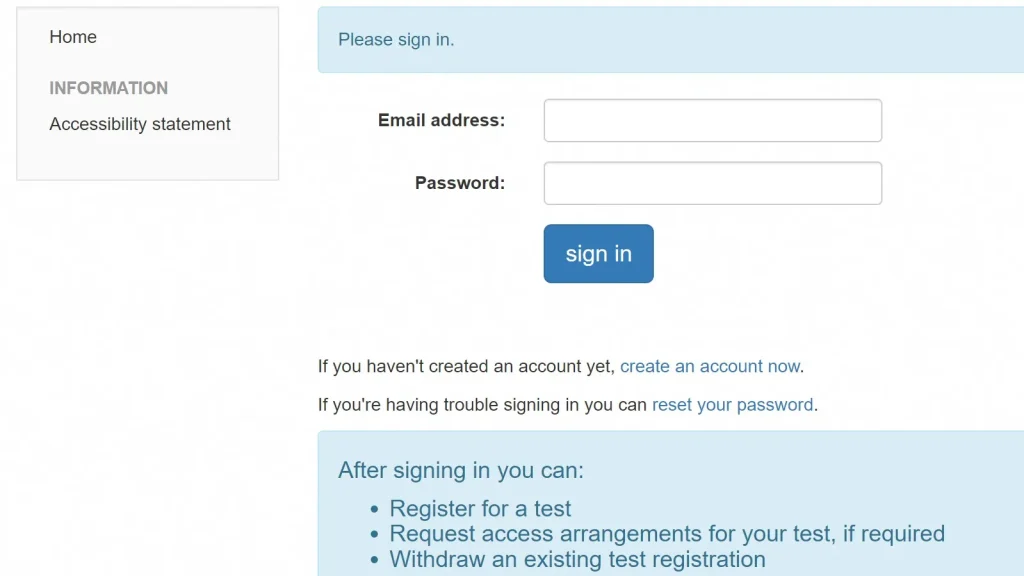
- During registration, you will need to provide your UCAS ID. If you have already submitted your UCAS application, you can enter your UCAS ID directly. If you don’t have a UCAS ID when registering, you may leave this field blank for the time being. However, it’s crucial to add it to your account as soon as you receive it; otherwise, the University will be unable to match your test result to your application.
- Select Your Programme of Study.
- After creating your profile, select your chosen programme of study from the drop-down menu. The system will automatically check whether your course selection requires the PAT. Programme codes can be found on this page.
- When you select an Engineering Science, Materials Science, or Physics-related programme, our system will automatically enroll you for the Oxford PAT.
- You can change your programme choice and register for alternative tests throughout the application period, from when registration opens until it closes.
2. Booking Your Examination with Pearson VUE
- Once you’ve registered for the Oxford PAT, you will be automatically redirected to the Pearson VUE examination booking platform.
- You are required to read and agree to the University of Oxford’s examination policies.
- When selecting a test centre, you can use the ‘Find a Test Centre’ function to locate nearby options. We strongly advise booking as early as possible to secure a place at your preferred test venue.

- Examination Booking.
- Select your test date.
- If your chosen test centre offers multiple sittings, you may select your preferred test time and book accordingly.
- Please check and confirm that your examination booking has been successful and that all your booking details are correct.
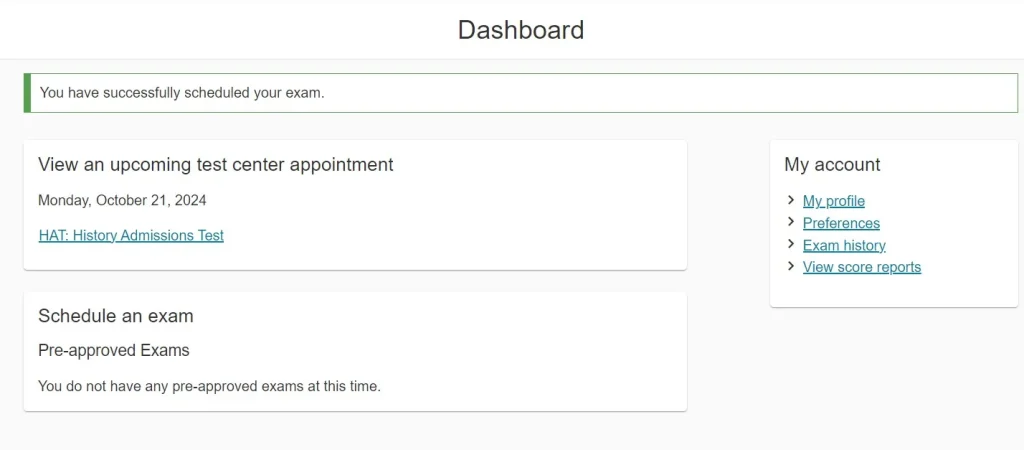
3. After Registering and Before the Examination
- Keep Your Confirmation Letter Safe: Upon successful booking, Pearson VUE will send you a confirmation email. This will contain the test date, time, test centre address, and other important instructions. Please read this carefully and keep it in a safe place.
- Ensure Your Identification is Valid: On the day of the examination, you must bring the original, valid, photographic identification document you used during registration. It is imperative to visit the official University of Oxford website or the Pearson VUE Oxford Admissions Test page beforehand to check the current list of acceptable forms of identification and to ensure your document will be valid on the test date.
- Understand Test Centre Regulations:
- In line with Pearson VUE regulations for University of Oxford admissions tests, you are not permitted to bring any personal belongings into the examination room.
- PAT is a computer-based test, with all answers completed on the computer. Physical scrap paper and pens, as well as calculators, formula sheets, or dictionaries of any kind, are not allowed in the test room.
- Official Contact Details: Should you have any questions, you can call the Pearson VUE candidate services helpline on 888 252 8564 (toll-free) or contact official customer service via the customer service centre on the Pearson VUE Chinese website.
4. Examination Fees
Unlike the TMUA/ESAT, the University of Oxford does not charge a fee for the PAT. However, some Pearson VUE test centres, particularly independently operated venues, may charge an administrative or invigilation fee.
III. Access Arrangements
- If you require Access Arrangements, you must indicate this by selecting ‘Need Access Arrangements’ (or similar, depending on the portal’s wording) during registration. If you don’t do this, you will need to cancel your original booking and rebook.
- Applications for Access Arrangements must be supported by written evidence from recognised medical or educational professionals or institutions.
- Note: Based on previous years, there may be an earlier deadline for submitting supporting documentation (e.g., mid to late September). It is crucial to consult the official University of Oxford website for the latest guidance and deadlines concerning Access Arrangements to avoid any delays.

- Note: Based on previous years, there may be an earlier deadline for submitting supporting documentation (e.g., mid to late September). It is crucial to consult the official University of Oxford website for the latest guidance and deadlines concerning Access Arrangements to avoid any delays.
- Select the type of Access Arrangement you require.
- If your required arrangement falls under Category 1, you may book your test yourself (please refer to the Oxford PAT Registration Procedure section above).
- If the arrangement falls under Category 2, you will need to complete a booking form. Pearson VUE will then book the test on your behalf and confirm the details by email.
- For clarification on Category 1 and Category 2 classifications, you are advised to refer directly to the detailed explanations on the University of Oxford’s official website, as these classifications may be updated.
- If the arrangement you need is not listed among the options, please select ‘Other’ and provide a detailed description in the pop-up box. In such cases, the University of Oxford will first review your request before contacting Pearson VUE on your behalf. Pearson VUE will then contact you directly.

- Should you encounter technical difficulties when applying for Access Arrangements or booking a test with such arrangements, you may contact Pearson VUE for support. However, please note that all decisions regarding eligibility and approval for Access Arrangements are made by the University of Oxford.
IV. Cancelling Examination Registration
- Oxford admissions tests are exclusively for applicants to the University of Oxford. If you register for the Oxford PAT but do not submit a UCAS application by 15 October, your test booking will be automatically cancelled.
- If you require Access Arrangements but do not submit the relevant documentation within the stipulated timeframe (this deadline is typically earlier than the standard registration deadline), your test booking will be cancelled. In this situation, provided it is still within the overall test registration and booking window (usually until early October), you may be able to rebook the test via the Pearson VUE system. If you do rebook, ensure all necessary supporting documents are uploaded immediately.
- Should you be unable to attend your booked PAT examination for any reason, you can typically cancel or amend your booking via the Pearson VUE booking system at least 48 hours before the scheduled test time. Cancellations within this timeframe do not usually incur additional charges. However, please be aware that while the University of Oxford does not charge a fee for the PAT, if your chosen independent test centre has charged an administrative fee, its refund policy will be subject to the centre’s own regulations. If you fail to cancel at least 48 hours in advance and do not attend the test, you may not be able to make further changes.
V. Concluding Thoughts
For candidates aspiring to read Engineering Science, Materials Science, or Physics related programmes at the University of Oxford, the Oxford Physics Aptitude Test (PAT) is of critical importance. Consequently, a thorough and timely understanding of the PAT registration procedure is particularly vital, as this can not only save considerable time but also help to ensure a smooth application process.
We invite you to explore our other articles via the link below. These include a comprehensive analysis of the Oxford PAT and a preparation guide, designed to support your study journey efficiently and thoroughly.

Oxford PAT Uncovered: Policy, Syllabus & Key Focus Areas
Applying for Physics, Engineering, or Materials Science at Oxford? This guide fully covers the PAT (Physics Admissions Test): latest policies, syllabus details (Maths & Physics, no FM), new online MCQ format (with online calculator), 100-point scoring, and how the R-score is used for shortlisting.
Ace the Oxford PAT: Mastering Maths, Physics & Online Test Skills
Aiming to ace the Oxford PAT test? This guide helps you master the essential Maths and Physics syllabus, develop crucial online test-taking skills (MCQ strategies, online calculator proficiency), and build a solid preparation plan for success in Physics or Engineering. - Please go to the registration portal and follow the on-screen instructions to create your account.